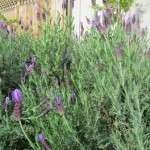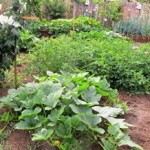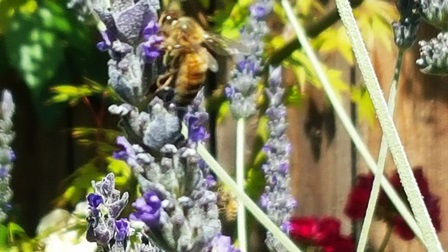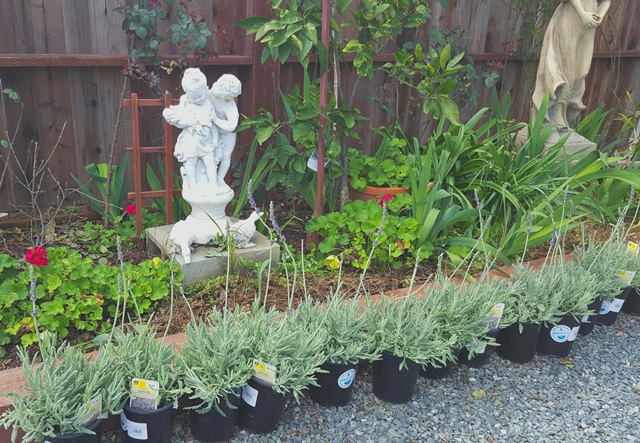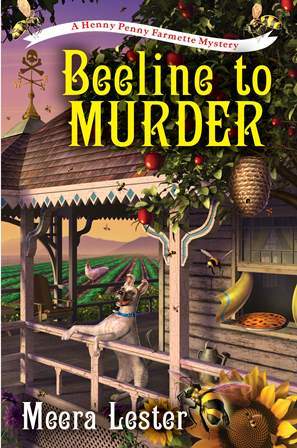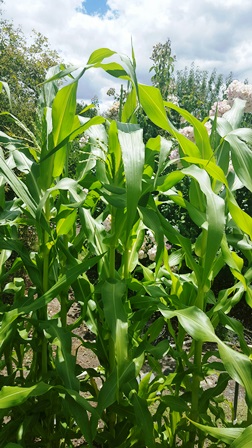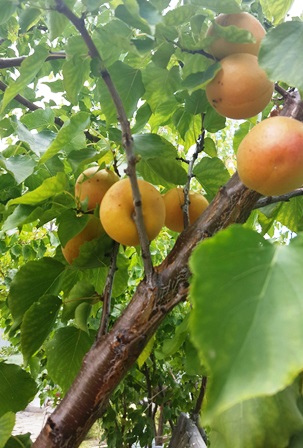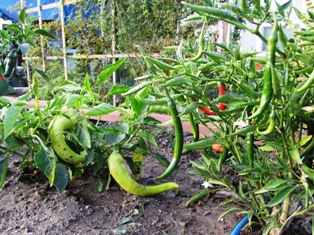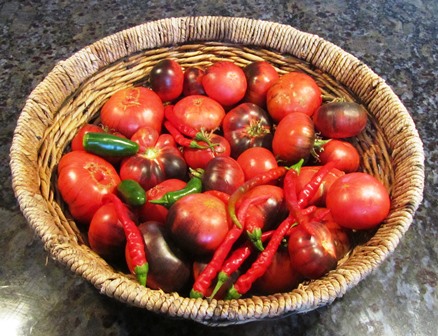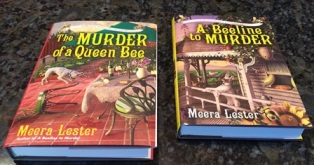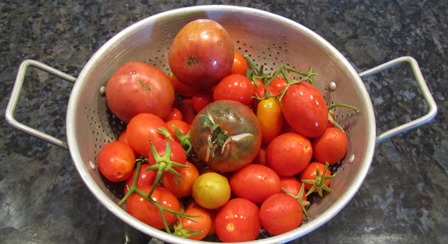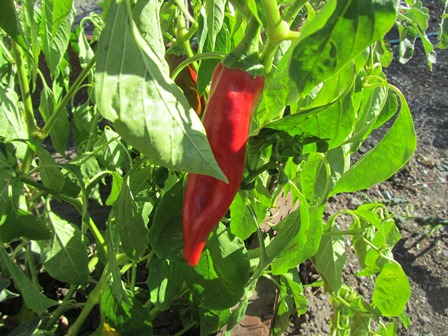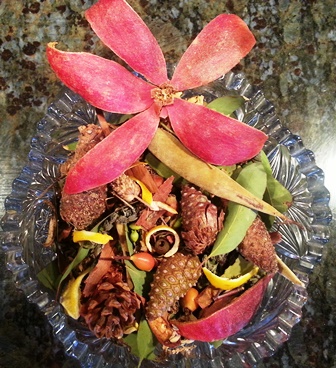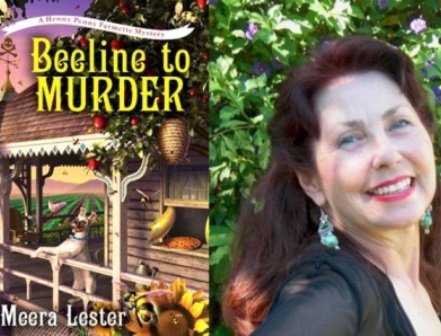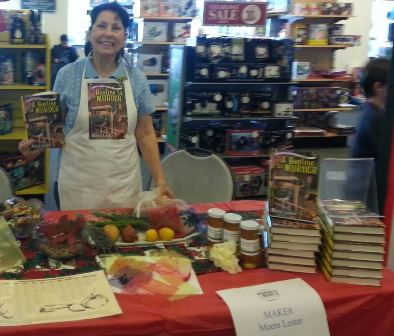Backyard Herbal–Hair Rinses and Hot Oil Treatments
In college, I often washed my then waist-long auburn hair with apple cider vinegar to keep the locks healthy and shining. And years ago, I discovered the decadent pleasure of a hot rosemary oil treatment and scalp massage that uses lavender oil.
If you grow your own herbs, making hair-care products couldn’t be easier.
The following are simple recipes you can make with home grown herbs and essential oils available in health food stores.
Apple Cider Vinegar Rinse Recipe: 4 cups of warm water to 1 cup apple cider vinegar. After you’ve washed the shampoo out of your hair, use the vinegar water as your final rinse.
Alternatively, you could add a couple of ounces of your favorite herbs like lavender, lemon balm, chamomile, or rosemary sprigs along with scented essential oils to impart shine and fragrance to your hair. Rosemary is also good for promoting hair and scalp health.
Rosemary Rinse Recipe: 4 cups of boiling water poured over 2 ounces of rosemary springs. Let set overnight under a lid or cover. The next day, strain out the rosemary sprigs and add to the liquid 10.5 ounces of apple cider vinegar and 10 drops of rosemary essential oil. Wash your hair, rinse, and as a final step pour through your hair the rosemary rinse.
For dry hair and scalp, create an oil treatment that you can do once every three weeks or a on a monthly basis. You’ll need rosemary, lavender, and a bit of tea tree oil (which possesses chemicals that may kill bacteria and fungus and reduce dandruff).
Hot Herbal Oil Treatment: 2 drops each of the following herbal oils–rosemary, tea tree, lavender–in 6 tablespoons of coconut oil. Thoroughly combine in a dark bottle, seal, and store. When you are ready for your hot oil treatment, sparingly apply the oil to strands of dry hair until all is lightly coated, not saturated. Cover with a hot towel for 15 to 20 minutes. Remove the towel and wash with shampoo as usual.
________________________________________________________
If you love all things natural, country, and homemade AND you enjoy a cozy mystery, check out my novels available online at Amazon.com, Barnes & Noble, Walmart, and other retail outlets as well as in bookstores everywhere.
For my newest novel, A HIVE OF HOMICIDES, click on the link: http://tinyurl.com/ya5vhhpm
Helping a Kitchen Garden to Grow in Clay Soil
Under the searing summer sun, the clay soil of my farmette will grow amazing pin oaks, white oaks, and pine trees. But for a gardener like me who wants to grow vegetables and herbs, clay soil frustrates and challenges.
Before planting next year’s kitchen garden in a new area of the property, I’ll have to change the soil structure now. This will take time and a lot of effort, but it will pay huge dividends over the long term.
Here are a few things things a gardener can do to improve clay soil.
1. A few weeks before working an area, mulch the area with an eight to ten-inch layer of wood chips to help the soil retain moisture and regain structure.
2. Use a pickax to break up the soil to the depth of 10 inches and work in composted organic material.
3. Avoid working the soil after a rain or when the ground is wet because the soil will ball up into unwieldy clumps.
4. Work in sand or perlite to create more pore space for aeration and drainage. Beware of adding too much sand; the soil becomes like concrete. Ideally, the soil should have roughly fifty percent pore space with minerals and organic matter filling in the rest.
5. When not growing plants, sow a cover crop of legumes to reduce weed germination, prevent erosion, and help water penetrate deeply into the soil. A legume cover crop provides plant matter that can be turned back into the soil or mowed, leaving the plant’s bio mass in place. Legumes fix the nitrogen in the soil that will nourish the plants of the kitchen garden.
6. Repeat all of the above steps annually and dig, turn, rake, and water. Over time, the soil should support healthy roots of plants and give you a robust kitchen garden that will provide many tasty vegetables and culinary herbs.
____________________________________________________________________
If you enjoy reading cozy mysteries and are interested in gardening/farming topics, keeping bees and chickens, or creating delicious recipes from heirloom vegetables and herbs, check out my Henny Penny Farmette series. All are available from Amazon, Barnes and Noble, and other traditional and online bookstores everywhere.
Coming 9/27/17
PUBLISHERS WEEKLY 08/14/2017 noted:
“Lester’s sensitive portrayal of Abby’s struggle with her wounded psyche raises this traditional mystery above the pack.”
See more at: https://www.barnesandnoble.com/w/a-hive-of-homicides-meera-lester/1125424538?type=eBook
French Lavender–A Favorite of Pollinators
It’s bare-root season, a special time of the year for me. I like to visit local nurseries and check out the new offerings of heirloom roses, fruit trees, berries, herbs, and flowers. No matter which nursery I visit, I always seem to spot the lavender first.
After we moved to the Henny Penny Farmette, we put in lots of French lavender. But after a few years, the stalks have grown old and woody.
Recently, on a visit to a nearby nursery, we purchased twenty one-gallon plants of French Lavender, an upright perennial that we’ve discovered blooms almost all year long in our Bay Area climate.
Now, they are hardening off in my garden until I get around to planting them.
The word “dentata” means toothed and a closer examination of the foliage reveals fringed indentations.
This aromatic, shrub has been around for centuries. Valued for its ornamental and medicinal properties, it also is used for soil erosion control. Once established, the lavender is drought tolerant.
Many gardeners love this lavender for its gray-green leaves. When other flowering plants in the garden have finished their blooming cycle, this lavender keeps producing tall spikes of bright purple florets.
Not as brilliant in color as the English or Spanish lavender, the French lavender is lovely grouped together in a single area where its flower stalks can sway in the wind. Our honeybees and other pollinators love it.
* * *
If you are a fan of cozy mysteries and love farmette topics like gardening of heirloom vegetables, herbs, and fruits as well as keeping chickens and bees, check out my Henny Penny Farmette series of cozy mysteries from Kensington Publishing.
Besides a cozy mystery to solve, these books mix in delicious recipes, farming and gardening tips, facts about keeping bees and chickens, and morsels of farm wisdom.
- COMING SOON– Sept. 2017, the third novel in the Henny Penny Farmette series
Thanksgiving Work Blesses the Giver and Receiver
On Thanksgiving, our family is usually grouped in the kitchen working our magic on individual dishes for our communal feast. But this year, things were different. My daughter is recovering from emergency surgery and her hubby has been trying to get over a bout of pneumonia. Their twin daughters had just come home from college, so when my daughter asked me if I would mind planning and shopping for the whole meal and then cooking it, I jumped at the chance.
My enthusiasm was not dampened by the fact that I was working on a new book and writing it against a “slam” deadline. Though this deadline is tighter than usual, I enjoy the topic, so it’s not really work. Ah, but there are other things to do as well. With the cold weather and the rain, I’m keeping a close eye on my plants, chickens, and bees. Still, Thanksgiving offered me a break from the norm. My daughter asked me to help make this holiday special and I wasn’t about to let her down. As it turns out, serving as the family chef lightened my heart and gave me the opportunity to be mindful of each special moment in our Thanksgiving day.
- There is always a passion for pecan pie in our family
Although I intended to do the cooking myself and had already baked the pumpkin and pecan pies and had whipped up a layered trifle for dessert, I asked my beautiful, brilliant granddaughters for help. There were sweet potatoes to peel, green beans to prepare, cornbread to be made, herbs to chop, and the turkey to be stuffed and cooked.
By two o’clock, the table was set, the food laid out, and the feast begun. We offered thanks for our blessings and asked for God’s grace on others and especially family members who hadn’t made the trip this time. Then, we made a special request for good health. The twins and I had used natural ingredients imbued with love for our food offerings and so believed that our gifts would put their mom and dad on the road to health in no time.
Today–Black Friday–I’m back to writing my book and feeling confident about the direction I’m going as well as the hours and minutes I have left to get there. And honestly, I’d rather be writing than shopping.
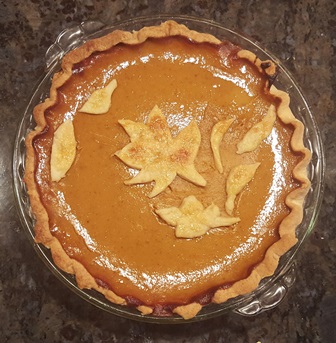
Our pumpkin pies feature leaves made from pate brisee dough, brushed with egg, and sprinkled with sugar before baking; they’re attached after the pie is baked.
Tonight, we’re going to eat leftovers with the addition of a simple winter salad–seeds from a ripe pomegranate, sections of a tangerine or two, slices of blood orange and a ripe pear tossed into some fresh greens along with small chunks of goat cheese and walnuts–drizzled with a toasted sesame dressing. And best of all, I can pluck most of the fruit walking around the farmette after I check on the plants, the bees, and the chickens. There’s work to do–plenty of it. But the way I see it, I’m honored to do work that blesses both the giver and the receiver.
* * *
Enjoy reading about farming topics? Check out my cozy mysteries–A BEELINE TO MURDER and also THE MURDER OF A QUEEN BEE (both in the Henny Penny Farmette series from Kensington Publishing).
These novels are chocked full of recipes, farming tips, chicken and beekeeping tips, sayings and, of course, a charming cozy mystery. For more info, click on the links under the pictures.
The books are available through online retailers such as Amazon, Barnes & Noble, Kobo Books, and Walmart as well as from traditional bookstores everywhere.
See, http://tinyurl.com/hxy3s8q
This debut novel launched the Henny Penny Farmette series of mysteries and sold out its first press run. It’s now available in mass market paperback and other formats.
See, http://tinyurl.com/h4kou4g
NEWLY RELEASED! This, the second cozy mystery in the Henny Penny Farmette series, is garnering great reviews from readers and industry publications.
Time Spent in a Potager Garden Renews the Spirit
With the official start of summer a few days away, I find myself leaving my computer and the scene I’m writing on my third novel to take a break in the garden. Alive with honeybees, bumblebees, butterflies, and hummingbirds, the garden is perfect place for a respite and a cup of tea.
Quite like a potager garden that includes flowers, herbs, trees, vegetables, berries, and grapes, mine also includes a patch of corn.
Embroidered around the edges of the garden, there are climbing roses, fruit trees, and lots of lavender. Along the rows of lavender, there are peach trees with fruit the size of softballs and five pomegranate trees, laden with blooms and new fruit.
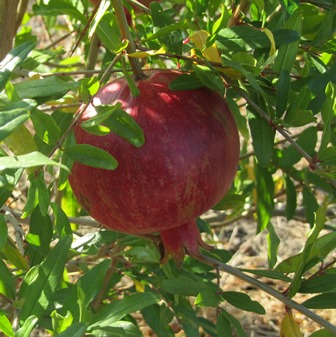
The pomegranates aren’t quite this large yet, but the trees have so much fruit, they’ll have to be thinned.
As I meander, I discover the trees of red and yellow plums have begun to drop their ripe fruit. I’ve got to make those plums into jelly or jam and ditto on the apricots.
But that work will have to wait until my late afternoon tea break. My novel won’t write itself. Still, the time I spend in the garden revitalizes my spirit and refreshes my brain cells, enabling me to return to the computer and the scene I’m writing with renewed vision and vigor.
* * *
If you enjoy reading about gardening, keeping bees, raising chickens, and creating delicious recipes, check out my novels from Kensington Publishing.
The Henny Penny Farmette series of cozy mysteries are available at Amazon, Barnes and Noble, Kobo Books, Walmart, and other online and traditional bookstores everywhere. Available in hardcover, Kindle, and mass market paperback formats.
Planting the Spring Garden
Winter brought us lots of rain and now the ground has warmed up and is ready to receive the heirloom seedlings of our favorite vegetables and herbs.
Tomatoes won’t set fruit until the nighttime temps hover around 55 degrees Fahrenheit, but I tucked in several seedlings of heirloom varieties (Bradley, Cherokee Purple, and Red Beefsteak). Victory Seeds offers a nice selection of open-pollinated, non GMO, rare heirloom seeds for a variety of tomatoes. See, http://www.victoryseeds.com/tomato.html
While I was digging, my neighbor’s bees decided to swarm. So I stopped gardening to check on my own bees. They’ve been humming like a truck engine, and there has been a lot of bee traffic. Concerned that they might swarm, I set aside my shovel and got out the swarm catcher, the lemon oil, and the hand pump sprayer. I positioned the swarm catcher in a tree across the yard, sprayed the tree with lemon oil, and went back to gardening.
I’ve readied a patch of ground for the sweet corn, squash, peppers, and beans. Also, in a large-size planter pot, I’ve tucked in flat Italian parsley, Italian oregano, dill, chives, and sweet basil. The patio pot will remain near the kitchen slider in full sun so I have culinary herbs at the ready when I need them.
The early sweet peas are taking off now and the garlic and onions I put in the garden last fall are about a foot high. The vegetables and herbs I plant now will provide me with plenty of nutritious offerings right up until late fall–one of the many reasons to plant a garden in spring.
Enjoy this blog? Check out my Henny Penny Farmette novels, available online and in traditional bookstores everywhere.
Finding Treasures in the Seed Catalogs
As a member of the grow-your-own-food movement, I pore over seed catalogs this time of year to search for heirloom vegetables that I want to grow on my farmette. If you’ve ever been inspired by the heirlooms (and not just tomatoes) displayed at a farmer’s market, you know what I mean.
Some wonderful heirlooms have fallen out of favor over the years and through generations. That’s a shame for those of us interested in maintaining the widest possible plant diversity. Gardeners often can find lots of heirloom tomatoes such as Cherokee Purple, Brandywine, Mortgage Lifter, and the “blue” tomatoes, including Indigo Apple. However, finding a great variety of heirloom vegetable seedlings might not be as easy as locating the tomatoes. That’s where rare seeds come in to play.
Seed companies that offer myriad heirloom varieties of vegetables and herbs send out their catalogs around mid-January each year. But their seed offerings can be perused and purchased online as well. Some of my favorite seed companies and their websites include:
Territorial Seed Company, http://www.territorialseed.com/
Baker Creek Heirloom Seeds, http://www.rareseeds.com/
Heirloom Seeds, http://heirloomseeds.com
Sustainable Seed Company, http://sustainableseedco.com/
Annie’s Heirloom Seeds, http://www.anniesheirloomseeds.com/
High Mowing Organic Seeds, http://www.highmowingseeds.com/
Eden Brothers Seed,nhttp://www.edenbrothers.com/store/heirloom_seeds.htm
Victory Seeds,http://www.victoryseeds.com/main_vegies.html
I’ve already removed empty cell packs, potting soil, and ice cream sticks(for plant labels) and placed them on the patio in preparation for starting my own seedlings from seed.
Once the seeds are planted in the cells, I’ll nurture along the seedlings until they are ready to go in the garden (after all chance of frost has passed). Then, Mother Nature will take over. I’ll enjoy sampling new varieties and saving seeds from those I want to grow again.
Heirloom Herbs for the Kitchen
The green stalks of the red and yellow onions I planted in late summer are now up about a foot in a raised bed. The garlic that I planted around the same time is also poking up. Having onions, garlic, and fresh culinary herbs available year-round is not impossible in the Bay Area’s mild climate, especially when they are grown in cold frames, protected areas, and raised beds.
Some will re-seed themselves in the growing beds or around your yards. We’ve got Greek oregano and chives growing all over the place. Some of my favorites herbs include basil, cilantro, chervil, chives, dill, fennel, lemon balm, lavender, oregano, mint, marjoram, rosemary, thyme, parsley, sage, and savory.
We also grow a few ornamental herbs such as borage, hyssop, and catnip (for our new kitty), tea herbs (chamomile and mint), and medicinal herbs (like echinacea).
Herbs are easy to grow. Their blooms will attract insects beneficial to the garden. Butterflies and hummingbirds are also attracted. And herbs don’t need much–light, and porous soil, warmth, and decent drainage. For a light feeding of the herbs, we make chicken poop tea. With so many varieties of herbs available, why not tuck a few in your garden or in containers in a protected but sunny and warm area of your patio to enjoy in your culinary creations?
Easy Peasy Holiday Potpourri
Potpourri mixtures are easy to create and their long-lasting fragrance can add an attractive visual appeal and fresh scent to any room. You can find many items in nature. Use a festive basket or crystal bowl for displaying your potpourri.
Go on a nature walk to hunt for materials (see the List of Potpourri Items below).
Visit a shop for spices–whole nutmeg, cinnamon sticks, cloves, and allspice.
Cut or purchase herbs (preferably dried)–lavender, rosemary, and mint.
Combine nature’s materials with spices, dried herbs, and dried citrus slices and peels.
Add rose petals, lavender buds, and/or pinecones and red cedar bark.
Arrange pretty seashells or small pieces of driftwood.
Include fresh leaves and berries from eucalyptus trees and also he fuzzy seed pods of wisteria.
Put the potpourri in a pretty basket or cut crystal bowl; add a drop or two of essential oil if desired.
LIST OF POTPOURRI ITEMS
Combine using any of the following to create interesting mixes, textures, and colors.
- pinecones
- eucalyptus leaves and berries
- rose hips
- citrus peels
- pomegranate peel
- lavender buds
- rosemary
- yarrow
- seed pods
- red cedar bark
- cinnamon sticks
- dried rose petals
- citrus slices
- allspice
- peppercorns
- dried nutmeg
- dried apple slices
- carnation petals
- seashells
- dried rose petals
- dried mint
- essential oil—(rose, lemon, lavender, vanilla) to intensify scent
Find other ideas for farm crafts and delicious recipes in A BEELINE TO MURDER.
Click here: http://tinyurl.com/nhdae39
Re-Cap of the Mini-Maker Faire at Barnes & Noble
My fingers still smell like French perfume lavender and rosemary from all the organza sachet bags I helped customers fill as a giveaway during the three day Mini-maker event this past weekend. Hosted by the Walnut Creek Barnes & Noble Bookstore, the event was a huge success for the store, the customers, and participating authors.
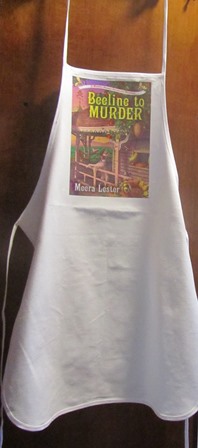
I wore an apron bearing the image of my book cover while I helped stuff bags with lavender and rosemary
All the signed copies of A BEELINE TO MURDER sold out and only a few unsigned copies are left. I gave away close to 100 organza bags and special embroidered bags I made for the event. Thank you citizens of the East Bay!
I met a lovely eleven-year-old boy who wrote novels. We exchanged email addresses and he’s already sent me his first two. I’ve promised to read and send him comments. All the while he was talking to me, I kept thinking “boy, did I get a late start writing.”
Another lovely customer bought the book for her mother back in North Carolina because winters on the other coast can be harsh, and a lover of mysteries can’t have too many on hand when the storms hit.
The mother of a Girl Scout invited me to do a presentation before their troop in early spring. I love the organization and will give it my best shot at the end of February or early March. It’ll be a chance to talk to the girls about writing books as a career, making things from nature, and having the courage to follow your heart (as I did when I established my farmette).
I enjoyed explaining to a darling Asian girl, while her parents looked on, the differences between wasps and honeybees. It was a great point of departure into a long conversation. We all became fast friends. She danced away holding her little bag of herbs beneath her nose.
In all, I had a great time. I think the store was pleased with all the “makers” who participated. And I’d do it again.
A BEELINE TO MURDER is available through your local Barnes & Noble stores as well as online at BarnesandNoble.com. Books make wonderful holiday gifts and foster the pleasure of reading.
 Facebook
Facebook Goodreads
Goodreads LinkedIn
LinkedIn Meera Lester
Meera Lester Twitter
Twitter






